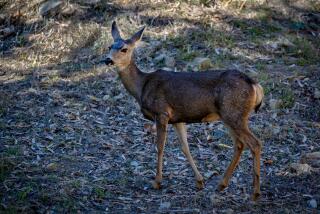Poison Drop Plan Targets Island’s Rats
- Share via
By the end of the year, helicopters could drop tons of poison pellets in an attempt to exterminate all the rats inhabiting rocky Anacapa Island under a plan the National Park Service released Tuesday.
If the aerial assault works as planned, it could lead to a profusion of native plants, flowers and seabirds to replenish those damaged by marauding rodents, scientists say.
But while rat eradication efforts have worked on some islands around the world, many such attempts have failed. The black rat is a formidable adversary not easily dislodged. They breed so rapidly, producing a new generation every three weeks, that just a single mating pair left behind could quickly repopulate the 700-acre island off Ventura County.
“Rats survived nuclear explosions in the Pacific. They are very adaptable creatures,” said Paul Collins, wildlife biologist at the Santa Barbara Museum of Natural History. “But Anacapa is a small island, so if they do a concerted eradication effort it could well work there.”
The program marks the first concerted attempt to get rid of the estimated 2,000 rats living on the three small islets that make up Anacapa.
“It will be a major milestone,” said Kate Faulkner, chief of natural resources management at the park.
The plan is part of an ongoing program at Channel Islands National Park to return native flora and fauna to the islands. More than a century of human settlement led to the introduction of livestock, pests and game animals that turned the fragile island environment upside-down. Species that have been or will be removed--using lethal and other means--include sheep, burros, cats, horses, rabbits, goats, pigs, elk and deer.
Poison bait was deemed the most efficient way to dispense with the rats, even though it could could kill an undisclosed number of hawks, gulls and owls unlucky enough to dine on a poisoned rat, officials say. Rats were the target of a limited eradication attempt at Anacapa during the 1980s. They are also present on San Miguel Island, though rats there are not targeted for eradication at this time.
Anacapa Island, a popular destination 11 miles off the coast, would be closed for a few days, either in November or December, during the extermination. Details of the proposal are contained in a draft environmental impact statement the Park Service released this week for public comment.
Island ecosystems are particularly vulnerable to alien species. Of the 484 cases of recorded animal extinction worldwide in the past 400 years, 75% have occurred on islands. Rats are responsible for up to 60% of those losses, according to the Park Service.
At Anacapa, rats prey upon chicks and eggs of nesting seabirds, including Xantus’ murrelet and ashy storm-petrels. Southern California’s Channel Islands host many of the world’s remaining populations of those rare birds.
To rid the islands of the rodents, the Park Service proposes dropping up to 9,700 pounds of the rodenticide brodifacoum. The first dose would be applied to east Anacapa late this year, and middle and west Anacapa isles would be treated in November or December 2001, according to the park’s plan.
Aerial application of poison bait was deemed safer than trying to set traps along cliffs and across the island, Faulkner said. It holds promise for killing the most rats with the least amount of time or risk to people or other animal species. Adverse effects on seabirds, fish and marine mammals are not believed to be significant, Faulkner said.
Some deer mice might perish at Anacapa along with the rats, but they can be replenished using stock from the islets not yet treated, Faulkner said. Some deer mice at the islands are infected with hantavirus, a potentially lethal disease for humans, but the Park Service wants to maintain them because they are native to Anacapa.
The rat-eradication plan is subject to approval by the Park Service’s regional headquarters and the U.S. Environmental Protection Agency in San Francisco. Public comments on the draft environmental impact statement can be sent to Channel Islands National Park Supt. Tim Setnicka at 1901 Spinnaker Drive, Ventura 93001, until Sept. 5.
A copy of the environmental impact statement is expected to be posted on the Web page for the national park later this week at https://www.nps.gov/chis. Paper copies can be obtained by calling the park at 658-5725.
More to Read
Sign up for Essential California
The most important California stories and recommendations in your inbox every morning.
You may occasionally receive promotional content from the Los Angeles Times.










